Description
Posts Table with Search & Sort is a WordPress table plugin which helps site owners organize WordPress posts into sortable and filterable tables, making it easy for your audience to find the content they need.
Visitors can easily filter content by date, category, tag or author – making this WordPress table plugin highly adaptable to different use cases.
Install this plugin to organize your WordPress posts into simple, searchable, and visibly appealing tables. It includes pagination and responsive layouts for smaller screens as standard.
To get started with this WordPress table plugin, simply add the shortcode [posts_table] to any page or widget.
Posts Table with Search & Sort (free) includes:
- Create sortable and filterable post tables.
- Choose any or all of the following columns: post ID, image, title, content, categories, tags, author, or date.
- Streamlined content using pagination.
- 100% responsive to different screen sizes.
- Display WordPress blog posts in a simple HTML table.
- WPML compatible for international translations.
Posts Table Pro – our premium version adds lots more functionality:
View free & pro comparison table
- Display posts, pages, or any custom post type (e.g. documents, audio, music, courses, products, staff and member directories, publications, articles, books, etc).
- Add extra columns: custom fields, custom taxonomies, post excerpts, status.
- WordPress media embeds, including audio and video galleries and media playlists.
- Showcase featured images in a lightbox and choose your image size.
- Dropdown filters for taxonomies, categories, and tags.
- Select posts by custom field, term, date, ID, and more.
- Advanced Custom Fields and ACF Pro support.
- Enable AJAX to reduce server load.
- 100% responsive, with options to control how behaviour on different screen sizes and devices.
- Support for advanced use cases such as how to create compelling tables for your blog, a WordPress document library, member directory, audio gallery, or an intranet for your organization.
- And much more…
WooCommerce Product Table – create product tables from your WooCommerce store:
- Include Add to Cart buttons, quantity, price, reviews, stock level, categories, tags, weight, dimensions, and more.
- Full support for WooCommerce products and stores.
- Create custom order forms which increase your conversion rate!
- Support for advanced use cases such as restaurant ordering systems, events calendars, and advanced order forms.
Translations for Posts Table with Search & Sort are currently provided for French, Spanish, German, Greek and Chinese (Taiwan). This data-table plugin is WPML-compatible for content translation, so if you’re using WPML, you’ll be able to display post tables in whichever language you have set up.
We make use of the jQuery DataTables library to power the searching and sorting features.
See the demo for examples of the plugin in action, and view the full plugin documentation in our Knowledge Base.
How to create your own WordPress Post Tables
You can use Posts Table with Search & Sort to display your content in searchable and sortable tables. This has a huge range of use cases, from a simple archive of your posts, to previews of your content, to sorting by author, tags, date, and more.
To list blog posts in a table, simply enter the shortcode [posts_table] to any WordPress page, post, or text widget. The easiest way to set your columns and other options is on the plugin settings page at Settings > Posts Table With Search & Sort. These global settings will affect all the posts tables throughout your WordPress site.
You can also add options directly to the shortcode. This allows you to configure each table individually – for example, in order to show different columns in each table, or to list posts from specific categories. Here are a couple of examples of shortcodes you can use:
- List your posts in a table with 4 columns (image, title, content, and date) showing the first 10 words of each post in the content column:
[posts_table columns="image,title,content,date" content_length="10"] - List posts in a table with with 5 columns (post ID, title, tags, date and author), and sort in ascending date order:
[posts_table columns="id,title,tags,date,author" sort_by="date" sort_order="asc"] - List posts in a table with rows on one line by using the parameter
wrap=false. If selected columns no longer fit in the table, then a “+” icon will appear to the left of each row to allow access to the rest of the data:[posts_table wrap="false" rows_per_page="5"] - List posts in a table sortable by any column. If the column does not appear in your table, it will be added as a hidden column at the end, so the ordering still works as expected. This example sorts each post by title. It also shows how to use
content_lengthto set the number of words in thecontentcolumn:[posts_table sort_by="title" columns="date,author,title,content" content_length=5 rows_per_page="5"]
You can see all of these in action on the plugin demo, and do even more with Posts Table Pro, our premium plugin!
Popular use cases for Pro take advantage of advanced features, including support for custom post types, advanced filtering, and media embed support, letting you build your own WordPress document library, create a WordPress file manager, or create a WordPress events table.
Here’s the full list of shortcode parameters you can use for this data-table plugin:
You can see some practical examples of how to build your own Post Tables above, and below you’ll find a full list of the shortcode parameters you can use to customize the output of your own Posts Tables. Remember, most of these options can also be set globally on the plugin settings page at Settings > Posts Table With Search & Sort:
columns– the columns you’d like to show in your table. This can be any combination of the following (comma-separated):id,image,title,content,categories,tags,author, ordate. Default:title,content,date,author,categories.rows_per_page– the number of posts to show on each page of results. Set tofalseto disable pagination. Defaults to 20 rows per page.category– restrict the table to this category only. Use the category ID or ‘slug’ here, NOT the name of the category. You can find the slug in the Posts -> Categories menu.tag– restrict the table to this tag only. Use the tag ‘slug’ or ID here. You can find the slug in the Posts -> Tags menu.author– restrict the posts in the table to the specified author. Use the author name (user_nicename), author ID or a comma-separated list of IDs.post_status– display posts with this post status (draft, pending, publish, future, private or any). Default:publish.sort_by– the column to sort by. Defaults todate. If the column you want to sort by isn’t shown in the table, it will be added as a hidden column. This means, for example, that you can sort by date without actually showing the date column.sort_order– whether to sort ascending (asc) or descending (desc). If you order by date, it will default todesc(newest posts first).date_format– you can set thedate_formatoption to choose the way the post date is displayed in the table. The default is Y/m/d. See this page for the full list of date formatting options.search_on_click– whether to enable automatic searching for categories, tags and authors when clicking on links in the table. Default:true.wrap– whether the table content wraps onto more than one line. Set tofalseto keep everything on one line ortrueto allow the content to wrap. Default:true.content_length– the number of words of post content to show in the table (if you’ve included thecontentcolumn). Defaults to 15 words.scroll_offset– advanced: the table scrolls back to the top each time you navigate forward or backwards through the list of posts. This value controls the ‘offset’ for the scroll. For example, if your site uses a sticky header you can adjust the scroll amount here to compensate. Enter a whole number (e.g. 50) or set tofalseto disable scrolling to top.
View the full documentation, checkout the demo, and if you need more features have a look at Posts Table Pro.
Thank you for using our WordPress table plugin ??
Screenshots
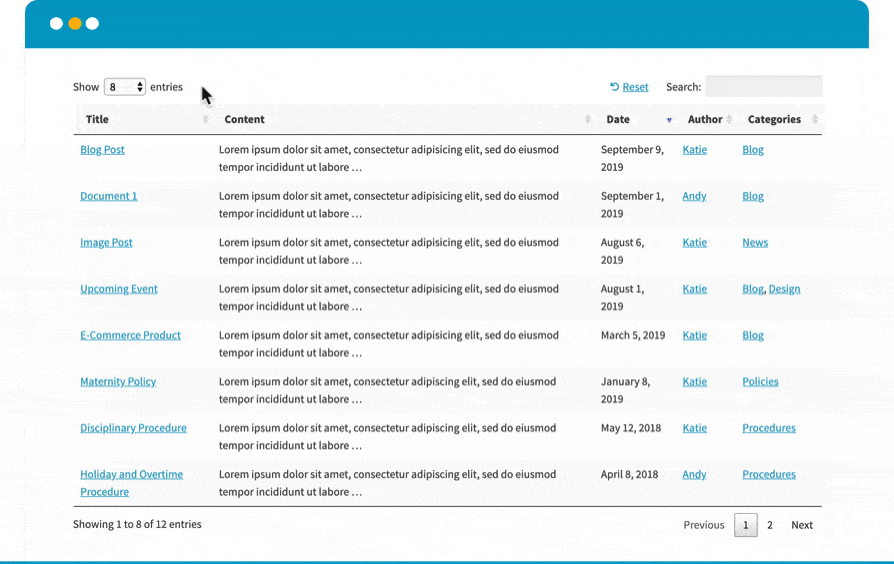
Searching and sorting a posts table. 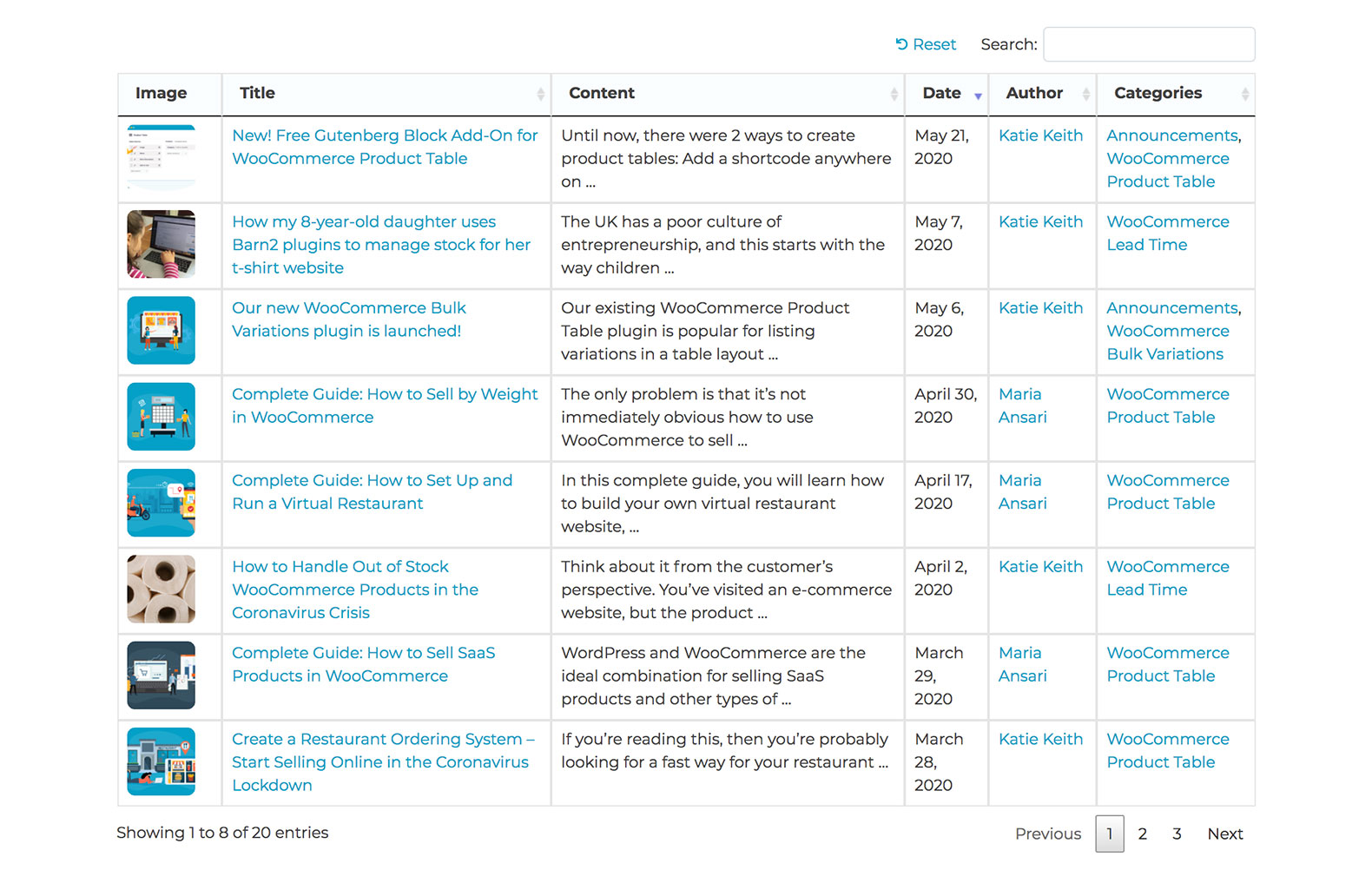
Choose your columns so users can quickly access post information. 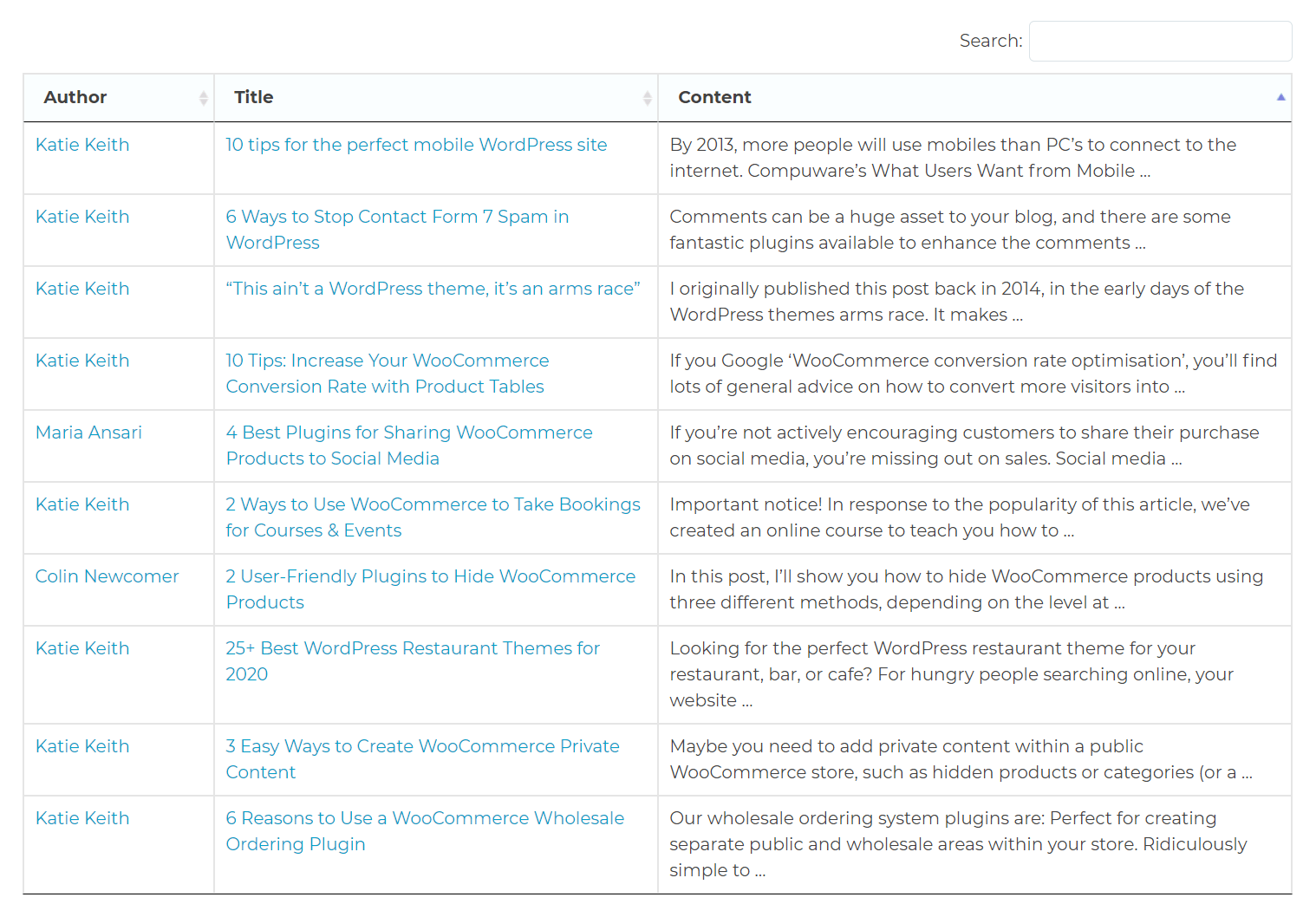
Sort by any column – this example shows a table sorted by Content. 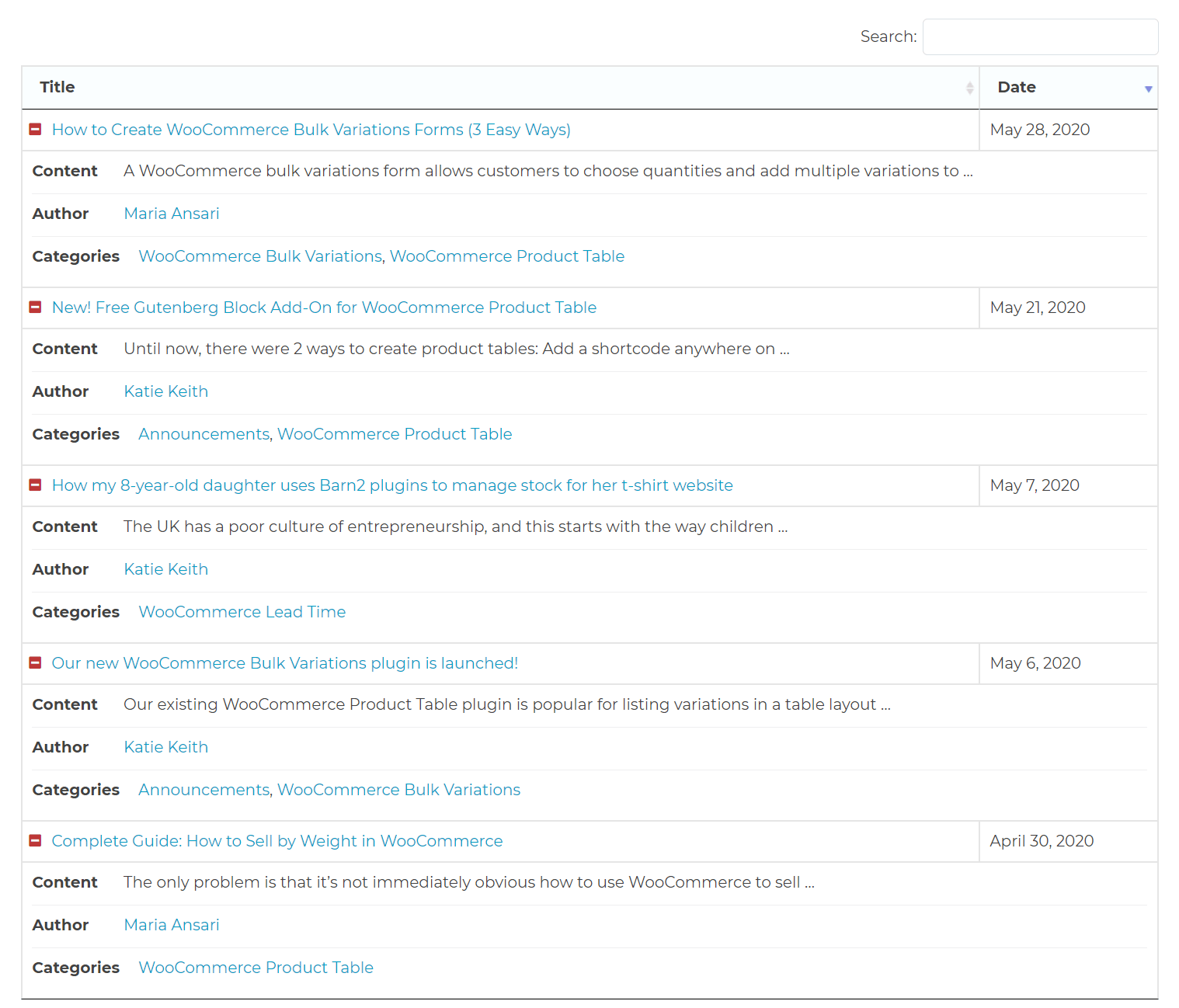
Prevent rows wrapping onto multiple lines – users can expand a row for extra information. 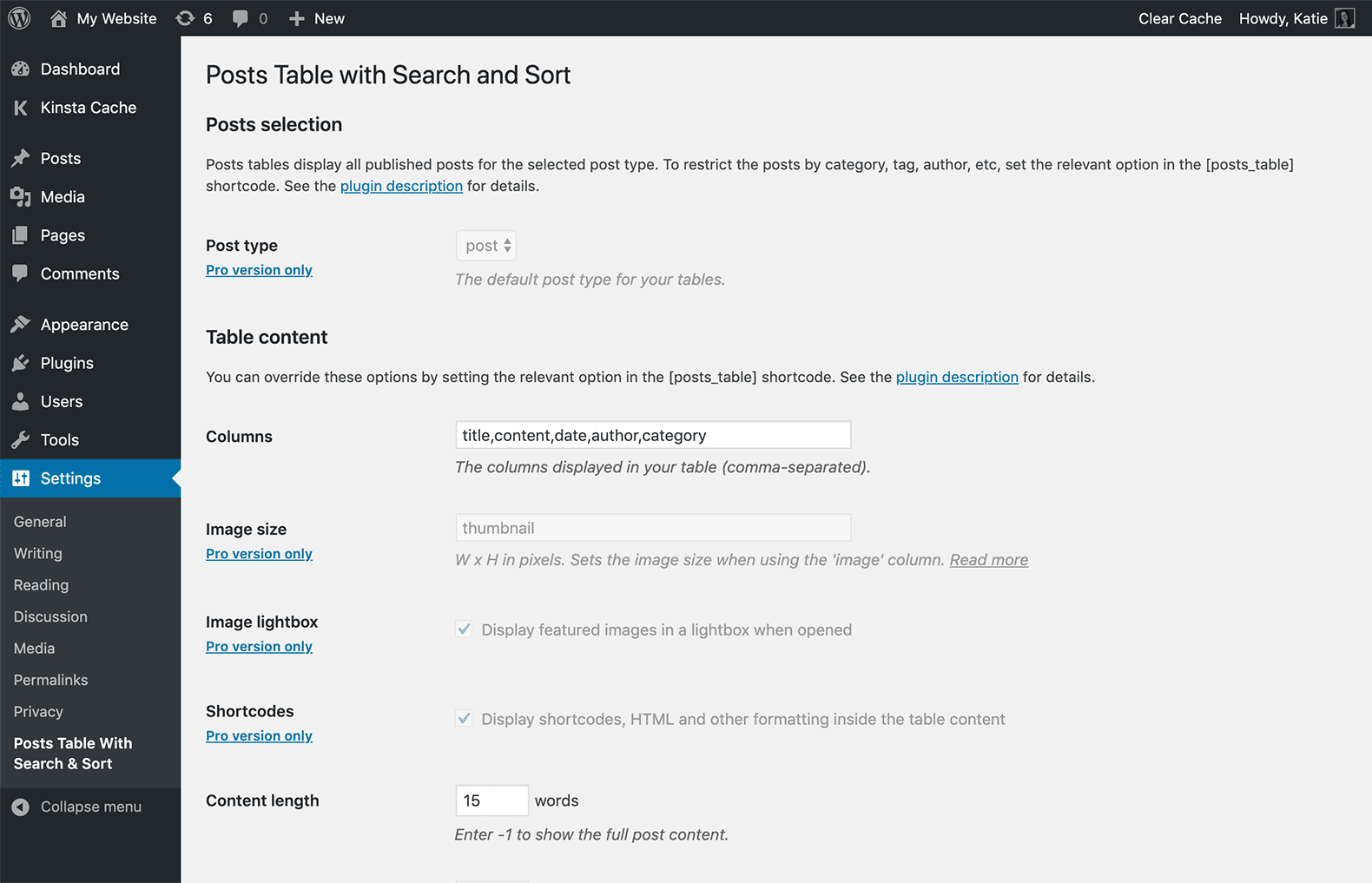
The settings page. 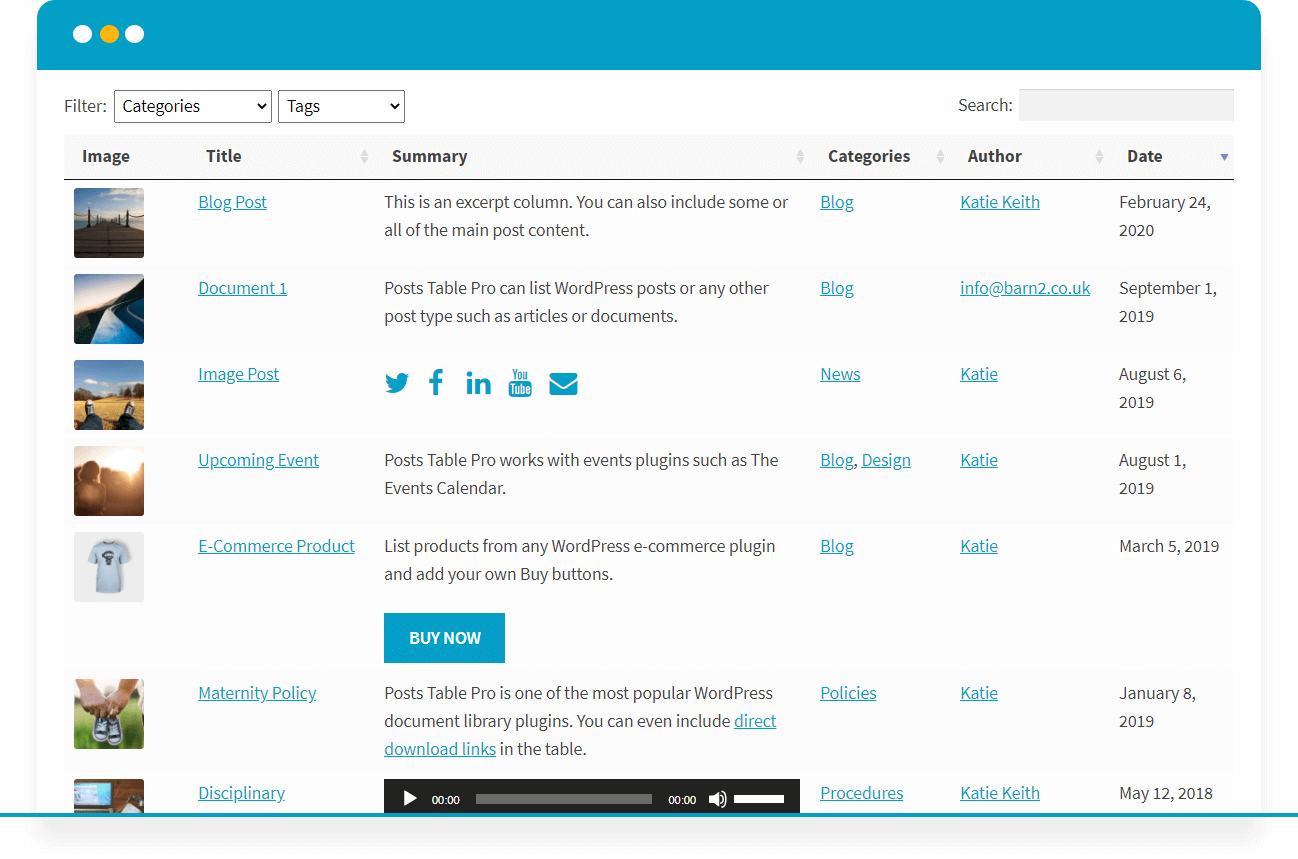
Upgrade to Posts Table Pro for premium features including custom post types, custom fields, multimedia embeds, and much more.
Installation
- Upload the plugin files to the
/wp-content/plugins/posts-data-tabledirectory, or install the plugin through the WordPress plugins screen directly. - Activate the plugin through the ‘Plugins’ screen in WordPress.
- Go to Settings > Posts Table With Search & Sort and configure your post tables.
- Add the shortcode
[posts_table]to any page.
FAQ
-
How do I display the posts table?
-
Simply choose your options at Settings > Posts Table With Search & Sort, then add the shortcode
[posts_table]to any page. -
Does it show all posts or can I restrict it to a certain category?
-
By default it will list all of your posts, but you can use the ‘category’, ‘tag’, ‘author’ or ‘post_status’ option in the shortcode to restrict the table to that category/tag/author/status only.
-
What are the shortcode options?
-
See the main plugin description above for the list of options.
-
Can I see a demo of the plugin?
-
Yes, please visit our plugin demo to see the posts table in action.
-
Will the posts table work with my theme?
-
The plugin has been designed to work with different WordPress themes and will take the styling from your theme for the fonts etc. where possible.
-
Does the posts table work with custom post types?
-
No, it only displays standard Posts. Our Pro Version supports custom post types, as well as taxonomies, custom fields, and much more.
-
Can I change the width of the columns?
-
The column widths are calculated automatically by the plugin, based on the contents of each column. However, you can override this for one (or more) columns by setting an exact width. You would need to add some code to your theme (or in a custom plugin) to do this. The filter to hook into is
posts_data_table_column_defaults. Here’s an example setting thetitlecolumn to 80px;add_filter( 'posts_data_table_column_defaults', 'posts_table_set_title_column_width' ); function posts_table_set_title_column_width( $column_defaults ) $column_defaults['title']['width'] = '80px'; return $column_defaults; }Bear in mind that the plugin might still override your column width if there isn’t enough room for the data it contains, or the rest of the columns in the table.
-
Does it work on mobiles/tablets?
-
Yes, the table will automatically adapt to fit different screen sizes. If your table has too many columns to fit on smaller screens then a ‘+’ icon will appear alongside each post, allowing you to click to view the hidden columns.
-
When I click to the next page on my posts list, I can’t see the top of the table
-
This is probably because you have a sticky header (your header sticks to the top of the screen when you scroll down). This means it’s covering the top of your posts table. You can add a ‘scroll offset’ to push the table down to prevent this from happening. For example, if your sticky header is 50 pixels high then use
[posts_table scroll_offset="50"] -
How do I use the posts table with WPML?
-
If you have a multilingual site using WPML then the plugin will display your posts in the correct language automatically.
-
Can you customize the plugin for me?
-
We developed this free plugin to be flexible and easy to configure so that it will be suitable for many different websites. If you would like to modify the plugin to suit your exact requirements, we would recommend Codeable
-
Where can I find the documentation?
-
Please visit our Knowledge Base.
-
Where do I report security bugs found in this plugin?
-
Please report any security bugs through the Patchstack Vulnerability Disclosure Program. The Patchstack team will assist you with verification, CVE assignment, and notify the developers of this plugin.
Reviews
Contributors & Developers
“Posts Table with Search & Sort” is open source software. The following people have contributed to this plugin.
Contributors“Posts Table with Search & Sort” has been translated into 8 locales. Thank you to the translators for their contributions.
Translate “Posts Table with Search & Sort” into your language.
Interested in development?
Browse the code, check out the SVN repository, or subscribe to the development log by RSS.
Changelog
1.4.7
Release date 18 November 2024
- Dev: Tested up to WordPress 6.7.0
- Dev: Updated internal libraries
See changelog.txt for more details.
